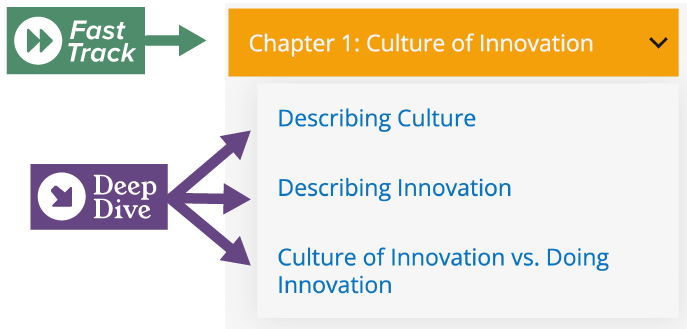

This is a Deep Dive page. Select the chapter for the Fast Track
Areas of Growth for Your Program
At this point in your journey, you have likely taken several foundational steps in developing a culture of innovation, such as recognizing existing successes, forming your culture of innovation team, making your program official, building your personalized playbook, and implementing and maintaining some plays. You are now at a critical juncture; if you lose momentum, your efforts will start to wane, and your organization may not see the value in continuing the investment. Beyond the specific plays in your playbook, your program itself needs to grow and mature if it is going to bear the results you are striving for.
This chapter provides the following steps to grow your culture of innovation program:
- Tend to your culture of innovation team. Is it expanding and evolving?
- Keep trying new things. What new problems need solutions?
- Keep moving forward. Are you focused on successes?
- Keep evaluating. Have you developed metrics?
Tend to Your Culture of Innovation Team
Ideally, your team should never stop growing and progressing. To that end, here are some ways to evaluate your team to ensure it focuses on growth:
- Performance. How is the team performing? Is it meeting regularly or losing momentum? Are meetings well-run, meaningful, and efficient? Are there any character traits or mindsets contrary to innovation that are negatively impacting the team? Are any politics at play harming the team?
- Evolution. Is your team changing in size or function? Is the team inviting new people from all business functions? Is it inviting those who are “change resistant“?
- Leadership. Has the team's leadership changed since the team was formed? Are leaders experiencing burnout? Has leadership been cultivating new leaders to take over?
- Goals. Are team members using and evaluating their goals in a culture of innovation playbook? Have goals and projects been prioritized? Is there mutual agreement on the prioritization of goals, or is there contention? Is the team using good decision-making processes to manage creative differences?
- Communication. Is communication among team members open so that ideas are exchanged, coordinated, and collaborated well? Are all team members given a seat at the table, and are their ideas listened to? Are there feedback mechanisms in place to demonstrate to all team members that their ideas are heard and valued?
- Team relationships. Are strong team member relationships developing that create and allow for more significant learning and contributions to innovation? Are members developing trust with one another?
- Cross-functional collaboration. Is there supportive collaboration being developed across teams, units, and divisions? Is trust developing here?
- External partnering. Is your team partnering with others? Is your team learning and growing from others in the industry? Is your team in regular contact with innovators in the area?
- Motivation/incentives. Are team members inspired to tackle new ideas? Are incentives/rewards that are developed to pursue innovation inspiring or motivating team members? Do new incentives/rewards need to be considered? Are you asking what motivates your team to ensure the right rewards are chosen?
- Recognition. Are team members adequately recognized for their contributions? Does this recognition impact career development opportunities?
- Mindset. Is your team's mindset evolving? Are people's mindsets becoming more innovative? Is innovation becoming a cultural mindset?
Keep Trying New Things
A continuous flow of new ideas is needed to keep innovation moving forward. It is important for the team to always be asking what new problems need to be solved. To that end, some areas to evaluate include
- Continual improvement. Are team members continuing to identify new challenges and needs? Are they prioritizing challenges to solve? Are they mixing in some problems that lead to quick wins to stay motivated by realizing regular successes?
- Knowledge transfer. Are team members keeping a list to document progress and avoid duplicating efforts? Are they communicating this list airport-wide so that everyone stays informed?
- Managing risk. Are team members encountering pushback related to risk? Are they seeking guidance and collaborating with others to work through potential ways to mitigate risk? Is the team considering partnering with outside organizations to alleviate some risk?
- Relationship development. Is your team establishing new relationships within, across, and outside the organization with partners to help solve different challenges? Are these relationships deepening and growing?
- Playbook/strategy. Does your team continually evaluate and assess progress made on plays that were implemented? Is the team considering new plays to incorporate so that all organizational elements are becoming more focused on problem-solving and continuous improvement? Has a playbook or innovation plan been formalized and disseminated to your team, as well as to key airport leaders and staff? What about governing entities?
- New perspectives. Does your team receive new training methods for skill development and career advancement? Are your creative processes evolving to look at things from new angles? Have you tried ideation sessions, hackathons, or similar strategies?
Keep Evaluating
As mentioned in the fruits, trees, and soil example from Chapter 1, if you want to drive innovation and continuous improvement into the culture, you need to measure how well the “soil“ is being nourished. Developing metrics to measure progress is a good way to make sure your culture of innovation program grows.
There are many different metrics that your organization can consider when it comes to measuring innovation. Key performance indicators are quantifiable measurements that airports can use to see how specific objectives are performing and to ensure accountability. They can also help the airport focus on new solutions for customers.
The following are a few examples of areas to measure:
- Total hours or percentage of time spent on innovation or problem-solving activities, as indicated on timesheets.
- How many people have been trained in innovative areas of study.
- Staff satisfaction levels when it comes to participating in the innovation process or on innovative teams.
- Leaders and managers can also be evaluated on any innovative training received or how often they apply innovative tools, like an innovative playbook or plan.
Any way you do it, make sure that you communicate these new metrics to your entire organization. They need to be clear to everyone so that everyone can find new ways to meet them. And, it cannot be stressed enough, make sure that any metrics developed do not come with unexpected side effects that can feel punitive to leaders or staff. It is also important for metrics to not encourage people to focus on reaching numbers rather than being truly interested in improving the way things currently are.
Much like the growth of a tree, your program's work to transition your organization's culture and mindset will take time. Your organization should prepare itself and anticipate slow yet steady progress.



